Plant Profiles dive deep on one plant variety each month. They are meant to provide you with enough information to make good growing decisions. A desire to grow gorgeous flowers is one thing. However, discerning if a particular plant is right for you and your climate is a whole other ballgame.
My intention here is to give you as much practical information to make these decisions. However, I’m going one step further and taking you completely behind the scenes to share exactly what has worked for us as well. For this reason, Plant Profiles are broken up into what I’m calling the “Nuts and Bolts (N&B)” and “Behind the Scenes (BTS).”
If you haven’t already, please be sure to read the FFY Introduction to learn more about how Plant Profiles are organized.
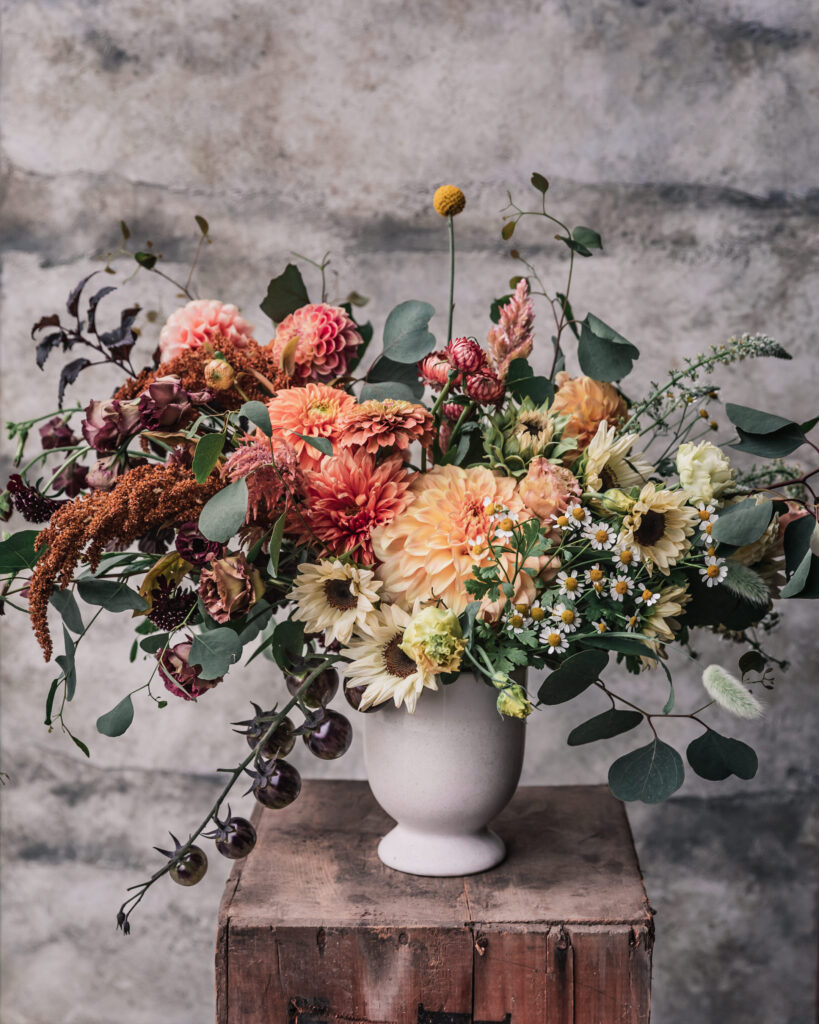
Cherry Tomatoes
This is my curveball plant profile for the year, and I hope you don’t mind. Something like a tomato might seem like it has nothing to do with floral arrangements, but I truly believe that including surprise elements like this is what can set you apart. Just this week, I had a customer tell me that every year for an event she gets a big arrangement from one of the most well-known floral businesses in our area. Last year, she ordered one from us instead (pictured above) and she said it was the most beautiful arrangement she’s ever gotten, so she’ll always be back. Specifically, she called out the cherry tomatoes because it was a conversation piece all evening.
Similarly, in my interview on the Local Flowers Podcast, Rechelle commented that she also includes cherry tomatoes in her arrangements and it always wows her customers. So, even though it may seem a bit niche, I thought it was an important one to cover. In today’s ever-increasing digital world, people are craving a connection to nature, and I see us (the growers) as a bridge to that connection. So, whether or not you have space to include tomatoes in your garden/farm, I hope at the very least it sparks creativity on what other unexpected elements could be part of your repertoire in order to inspire and connect others. Nature provides us an infinite amount of possibilities. P.S., this is a little hint that I plan to continue to add to the Plant Profile Library far more than 12.
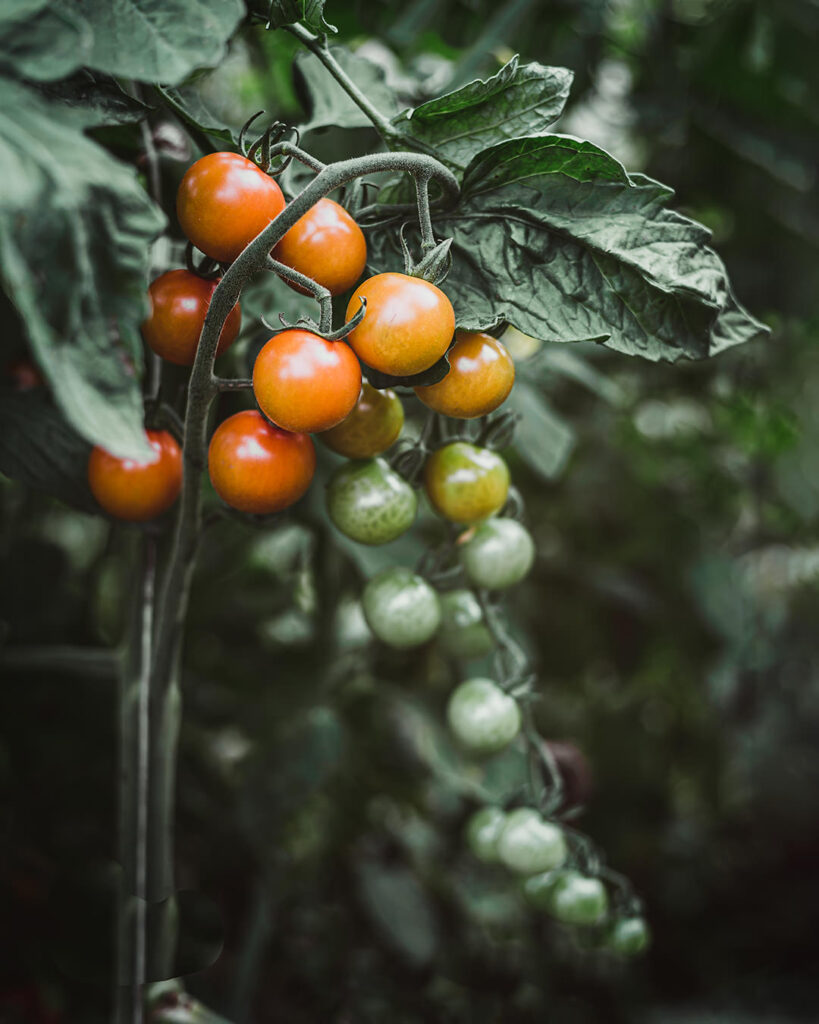
Primary Sources
Long before I grew flowers, I was primarily a vegetable/herb grower. So much so, that we considered starting a market farm. The resources for this month come from two of my vegetable growing heroes: Jean Martin Fortier and Eliot Coleman. Much of their principles are still at the heart of our farm today, and I wouldn’t be where I was without their knowledge. If you’ve been around, you know I’m a huge fan of Johnny Seeds, and they’ve worked closely over the years with Eliot Coleman to design many of the tools that they offer. If you don’t have these books already, I highly recommend them for anyone’s library.
The primary sources for the N&B portion come from:
- The Market Gardener: A Successful Grower’s Handbook for Small-Scale Organic Farming (Fortier).
- The New Organic Grower, 3rd Edition: A Master’s Manual of Tools and Techniques for the Home and Market Gardener (Coleman)
- Johnny’s Selected Seeds (Johnny’s): Johnny’s has been in the business for 50 years, with a research farm dedicated to finding the best seeds and tools for farmers and gardeners
Zone Considerations
- Coleman’s farm is located in Maine Zone 5
- Fortier’s farm is located in Quebec Canada Zone 5
- Johnny’s Selected Seeds research farm is located in Zone 5a Maine
- My farm, Petal Back Farm, is located in Zone 4b Wisconsin

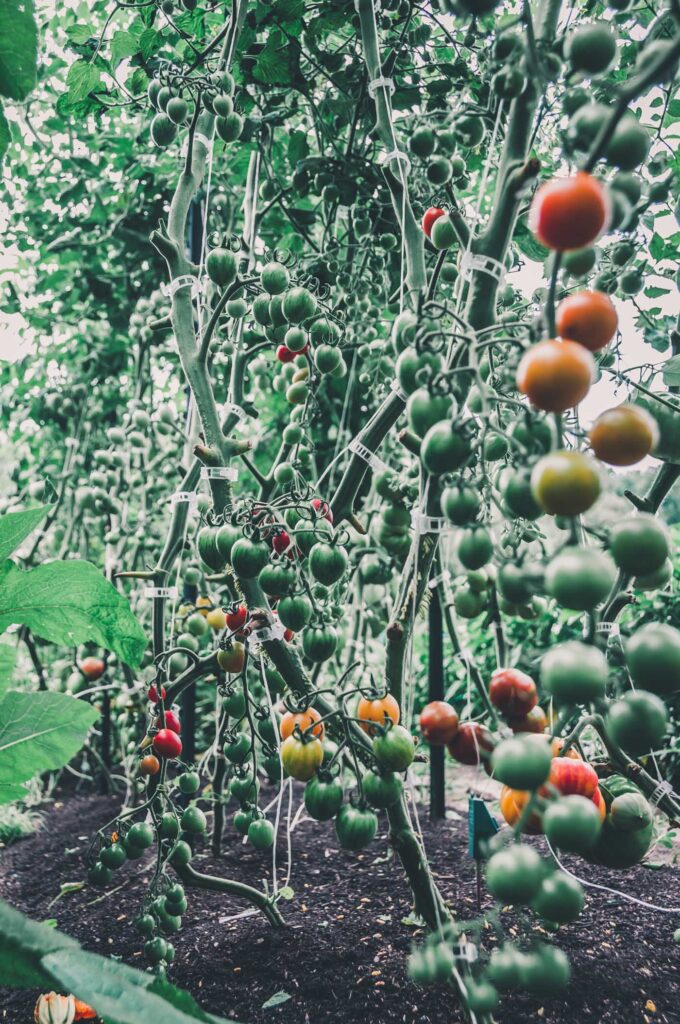
General Information: N&B
- Latin Name Name: Solanum lycopersicum
- Common Name: Tomato
- Origin: South America, Mexico, and Central America
- Days to Maturity: Variety dependent but on average 60–70 days
- Life Cycle: Perennial but in most areas grown as annual
- Spacing: Can depend on growing conditions, but typically 1 foot between plants and 4 feet between rows
- Height: Depends on variety, pruning, and growing conditions
Tomatoes are one of the most-cultivated crops worldwide. For this particular plant profile, we’re focusing on indeterminate cherry tomatoes (those that create vines/clusters). “Indeterminate” refers to the plant habit. There are two major types of vegetative growth habits in tomatoes (determinate and indeterminate), plus some other, less clearly-defined subtypes with in-between features (semi-determinates and dwarves).
Indeterminate tomatoes are vining types that continue grow new leaves, shoots, and flowers for an indefinite time period, while determinate are bush-type tomatoes with one or two relatively concentrated main harvests (Johnny’s). The plant habit will affect how the plant is cared for, so I wanted to call that out (all reputable seed companies will list whether a variety is determinate or indeterminate on the seed packet).
General Information: BTS
I cannot imagine a summer without vine-ripened tomatoes. I grew tomatoes long before I ever grew flowers and I’ve trialed well over 50 varieties over the years. While I’m going to focus here on varieties great for floral design, I highly recommend The Heirloom Tomato by Amy Goldman Fowler if you’re interested in the culinary side. I prefer the indeterminate varieties for their trailing vines/clusters and also for their continued harvests.
What I love most about cherry tomatoes:
- Easy to grow
- Unexpected
- Wide array of colors
- Adds a touch of whimsey
- Bonus: Cherry tomatoes are delicious
But every rose has its thorn, right? Potential shortcomings:
- Some varieties do not hold well on the vine (the tomatoes fall off, more tips on that below)
- While they’re easy to grow, they do require some labor (support, pruning, etc.)
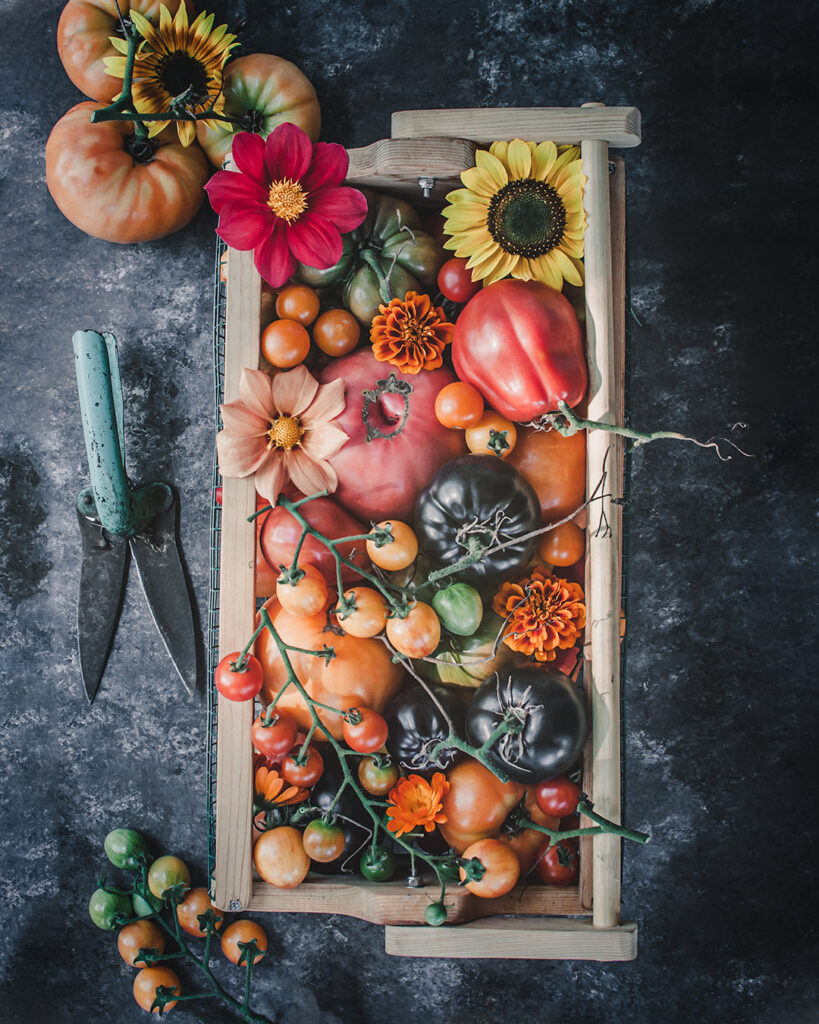
Propagation: N&B
Tomatoes are grown from seed. You can usually buy plants through nurseries or garden centers, but growing from seed is SO easy and there are an endless amount of varieties.
Johnny’s recommends the following: About 5–6 weeks before transplanting, sow 1/4″ deep in 20-row flats with 20 seeds/row, or in 200-cell trays with 1 seed/cell; lightly cover. Keep mix at 75–85F (24–29C) with moderate moisture. At first true leaf, pot-up to 50-cell trays or 4″ pots, depending on expected transplant timing. Grow at constant 60–70F (16–21C). Similarly, Coleman starts seeds in mini soil blocks at 72F (22C), potting up to 2-inch soil blocks at 62F (17C) and then eventually 4-inch blocks,
Propagation: BTS
I’ve always grown tomatoes from seed because they are just so dang easy and then you have so many varieties available to you. I don’t use 200-cell trays because I don’t need that many, but I start with whatever smaller trays I have on hand (anything from small 6-cell inserts to a 72-cell tray) and then pot up into either deep 50-cell trays or 4–6″ pots. I start all plants indoors in our basement which hovers between 65–70F (18–21C). I *always* pot up my tomatoes and it’s for one very-specific reason. If you grow tomatoes or have seen a tomato plant, you’ll notice that the stem is fuzzy. All these little hairs will turn into roots if they are buried. For this reason, I always pot up my tomato plants deeply, burying up to the true leaves in soil. This not only encourages strong root growth but also reduces the chance of leggy plants.

Environmental Factors: N&B
Coleman and Fortier primarily grow indeterminate tomatoes in greenhouse production systems (high tunnels, minimally or non-heated). Their reasoning for this is because this approach eliminates most diseases commonly found with outdoor operations and extends the growing season by almost two months. They grow indeterminate varieties using greenhouse production methods because it increases yield tenfold (more on this below). For the market farmer, tomatoes are one of the most-profitable crops, so it makes sense to dedicate this space to them.
That said, you do NOT need a tunnel to grow amazing tomatoes. Tomatoes can successfully be grown in the field or containers, so long as temperatures get sufficiently warm and plants are grown in full sunlight (at least 6 hours, but ideally 8–10). Tomatoes produce the largest yield of highest-quality fruit when daytime temperatures are in the range of 80–86F (26–30C) and when night temperatures remain above 65F (18C) (Fortier). Avoid exposing unprotected plants to consecutive nightly temperatures below 45F (7C) (Johnny’s). Tomatoes prefer medium-rich soil with pH 6.0–6.8. Johnny’s recommends mulch and regular pruning (more on this below) to ensure the highest yielding crop of tomatoes.
Environmental Factors: BTS
I’ve grown tomatoes for many years in a variety of environments with great success: high tunnel, field, raised garden bed, and even these fabric pots! Unless you have really cold summers or a very shaded area, you can likely grow tomatoes following the recommendations in this profile in a variety of ways with great success.

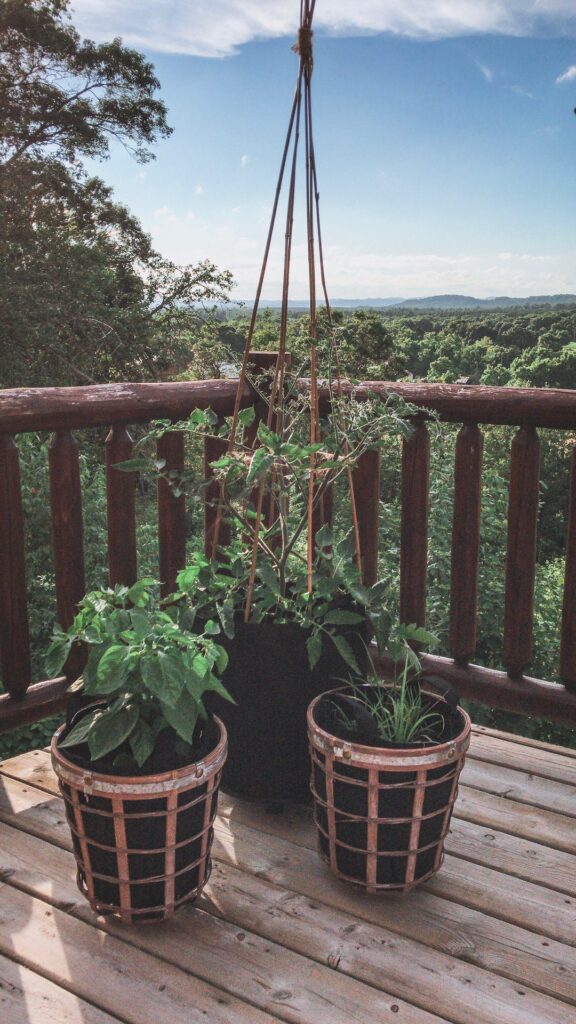

Transplanting, Spacing, Support: N&B
Tomatoes should be hardened off before transplanting and planted after last frost or under protection. Coleman grows plants in two rows 30 inches apart, so as to provide 4 square feet between plants (I typed this exactly how he wrote it, but I am having a hard time visualizing exactly what that means; if you are too, you are not alone 🙂 ). Fortier grows one row with plants at 9-inch spacing (24-inch wide beds with 36-inch pathways). Johnny’s notes that the standard recommendation for tomato spacing is 1 foot between plants and 4 feet between rows. With heirlooms, wider spacing in either or both directions will improve air flow.
Indeterminate tomatoes benefit from pruning (I would argue it’s essential, more on that below) and require some type of support as they can easily get over 10 feet tall (though they can be topped; they do not need to get this tall). Coleman uses overhead supports with twine attached that is tied loosely to the base of the plant and twisted around the stem as it grows (he prunes to a single leader).
Fortier’s system comprises of two steel wires suspended lengthwise above each bed at a height of 8 feet, fastened at both greenhouse end walls to a tightened cable. The plants are trained up twine attached to a hook on the steel wire (plants are pruned to a single leader).
Johnny’s notes that indeterminate tomatoes can be trellised by Basket Weave (instructions), Stake-&-Wire Trellis (facebook post) / Hanging-String System (video), or Stake & Trellis system (T-Posts and with Hortonova Netting–similar to a trellis system for sweet peas). For their field tomatoes, Johnny’s prunes to two leaders.
Transplanting, Spacing, Support: BTS
I always harden off tomato plants before transplanting. When transplanting, once again, I bury deep (I’ll even remove bottom sets of leaves and bury up to the next set).
Our beds are about 3–4 feet in width. I grow tomatoes in one row with plants 12 inches apart (I’ve also done two rows in the field, 30 inches between rows, with plants 24 inches apart). In our raised bed, I only grow two plants: one per bed that is connected via an arch trellis. I usually prune my indeterminate tomatoes to two leaders (why? I don’t know, I find that I get a lot of tomatoes this way and it just works for me).
I’ve used many different trellising systems throughout the years: the basket weave, cattle panels (basically cattle panels attached to T-Posts and vines tied to the panels, I have a blog post that details this method here for squash, but it’s the same exact thing), trained up an arch, and hanging-string system.
While I love the arch in the kitchen garden, my favorite for larger production is the hanging-string system with clips (I’ve also just wrapped twine without the clips, like Fortier and Coleman mention, but the clips are easier for me). Doing this in the field, I pound T-Posts (at least 6 feet tall) into the ground, 5 feet apart. Then, I attach a 10-foot length piece of rebar to the top of the T-Posts with wire or twine (so essentially, there are 3 T-Posts for each 10-foot piece of rebar: one on each end and one in the middle). I tie poly tomato twine to the rebar and use clips to attach the tomatoes (you don’t need clips, you can just wrap twine, but I find the clips easier). We could use wire instead of rebar, but these are all things we had on hand at the time. I use this same system in the high tunnel except that instead of rebar, we have a cable wire above the plants fastened to the tunnel. The plants are trained up poly twine that is attached to hooks on the steel wire.
Hanging-String System in action throughout the season:

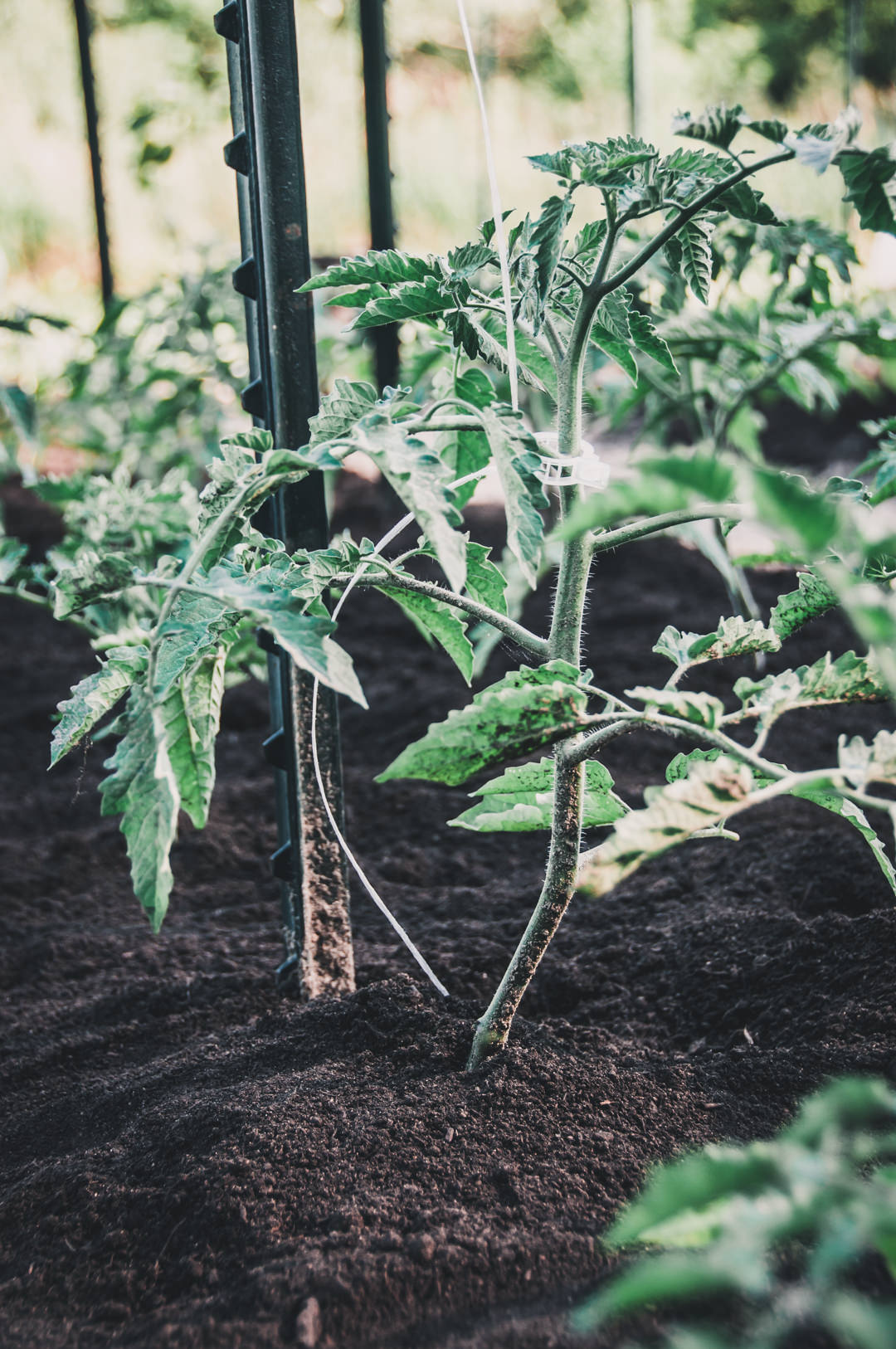

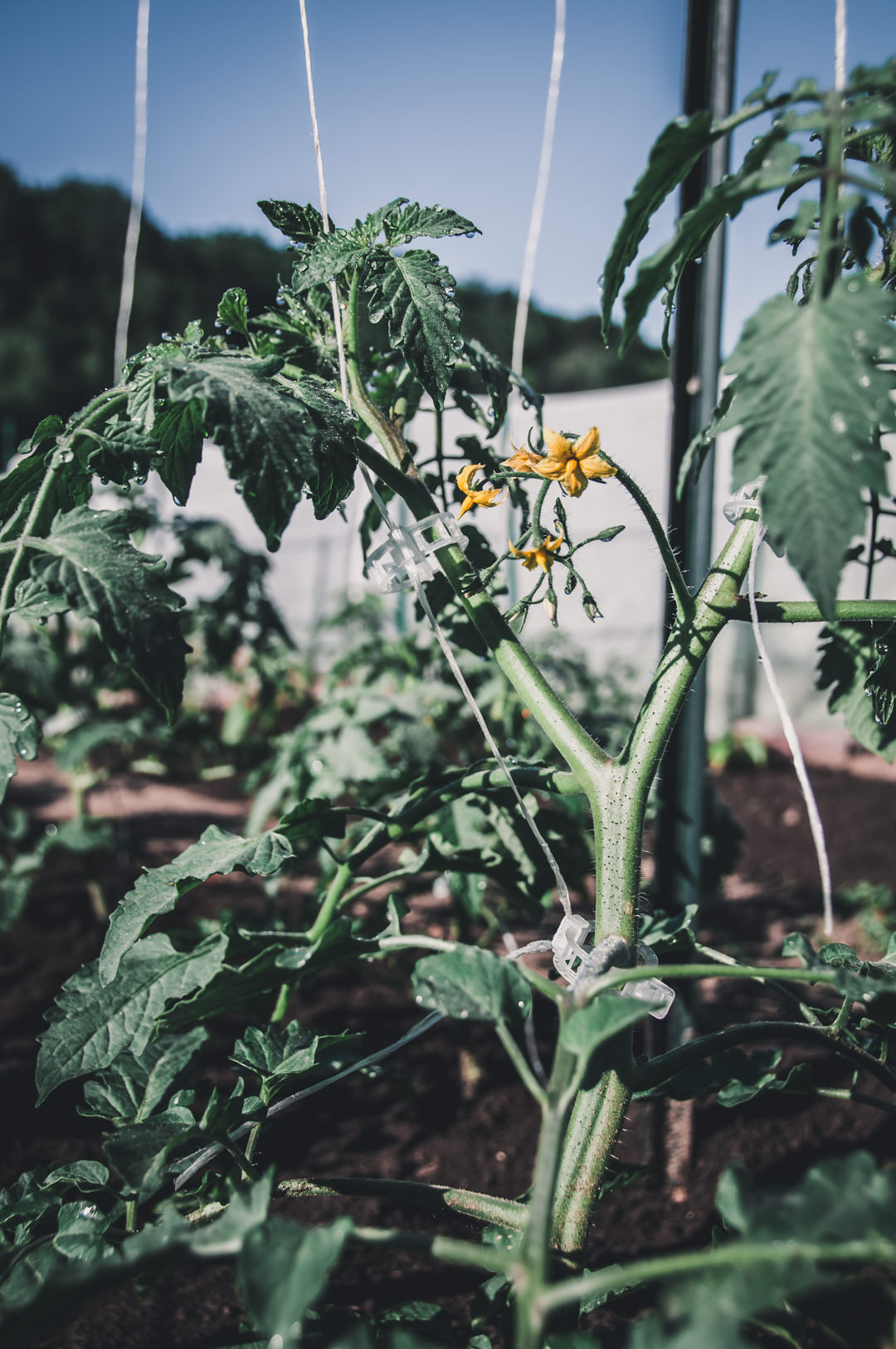
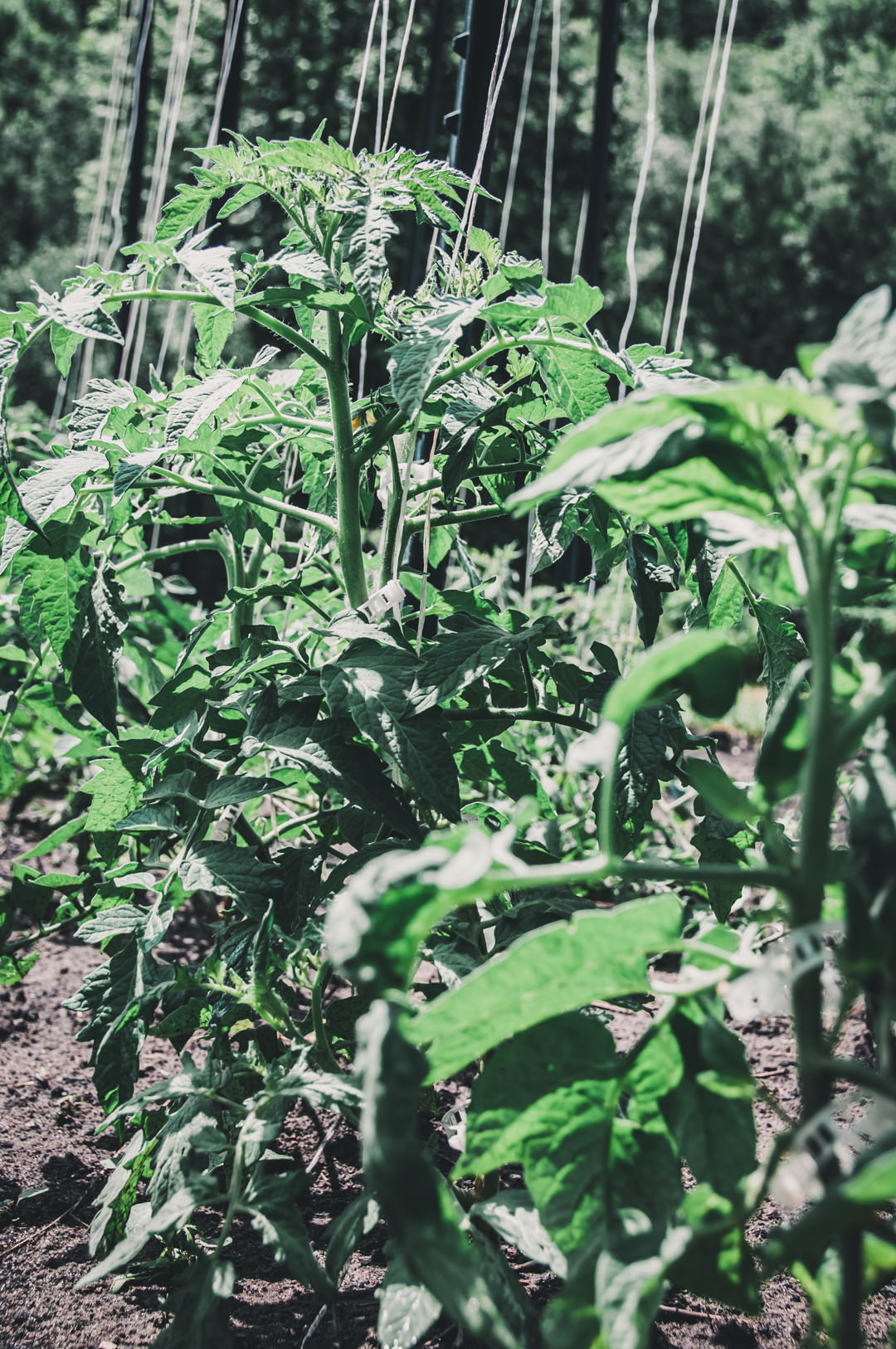
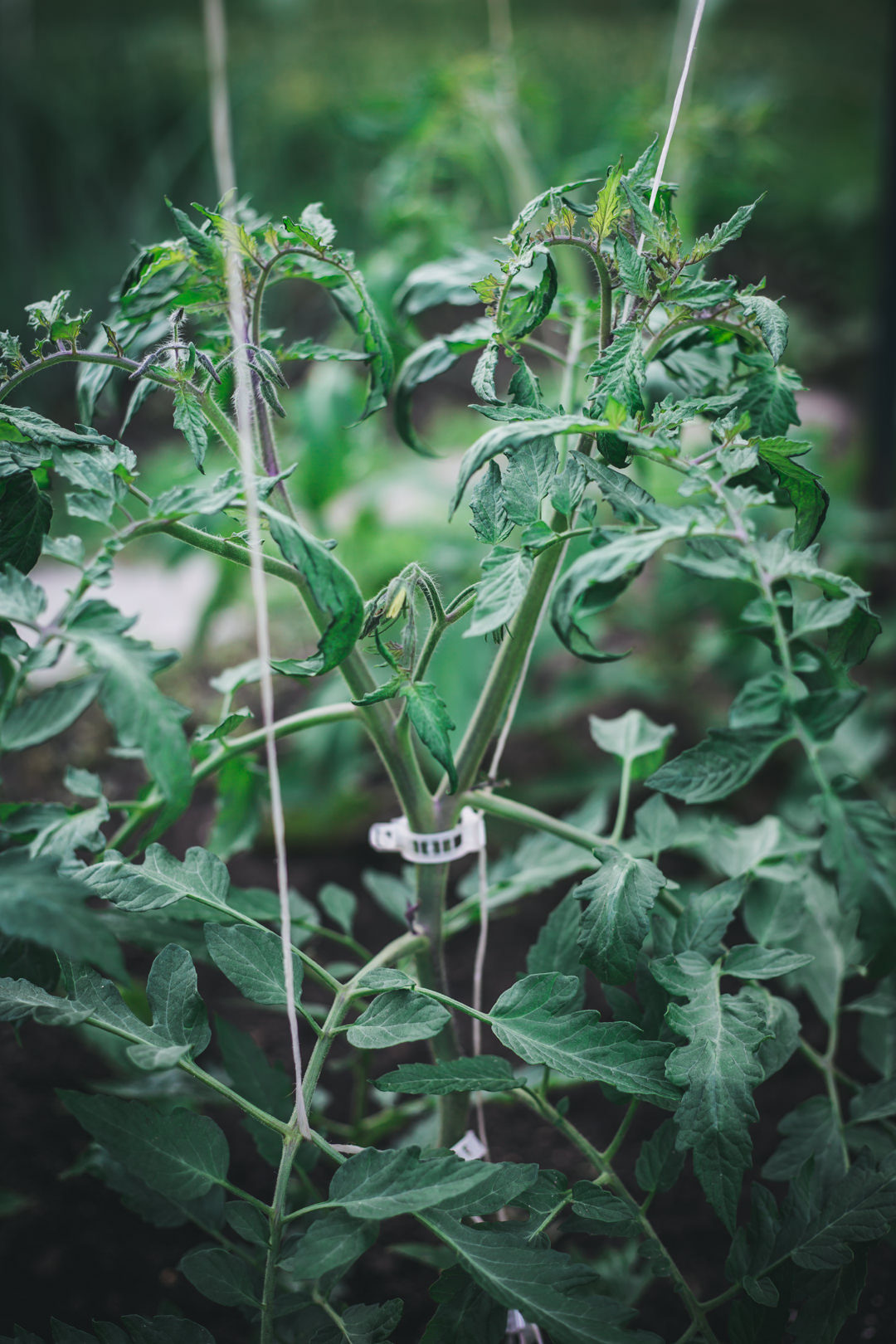
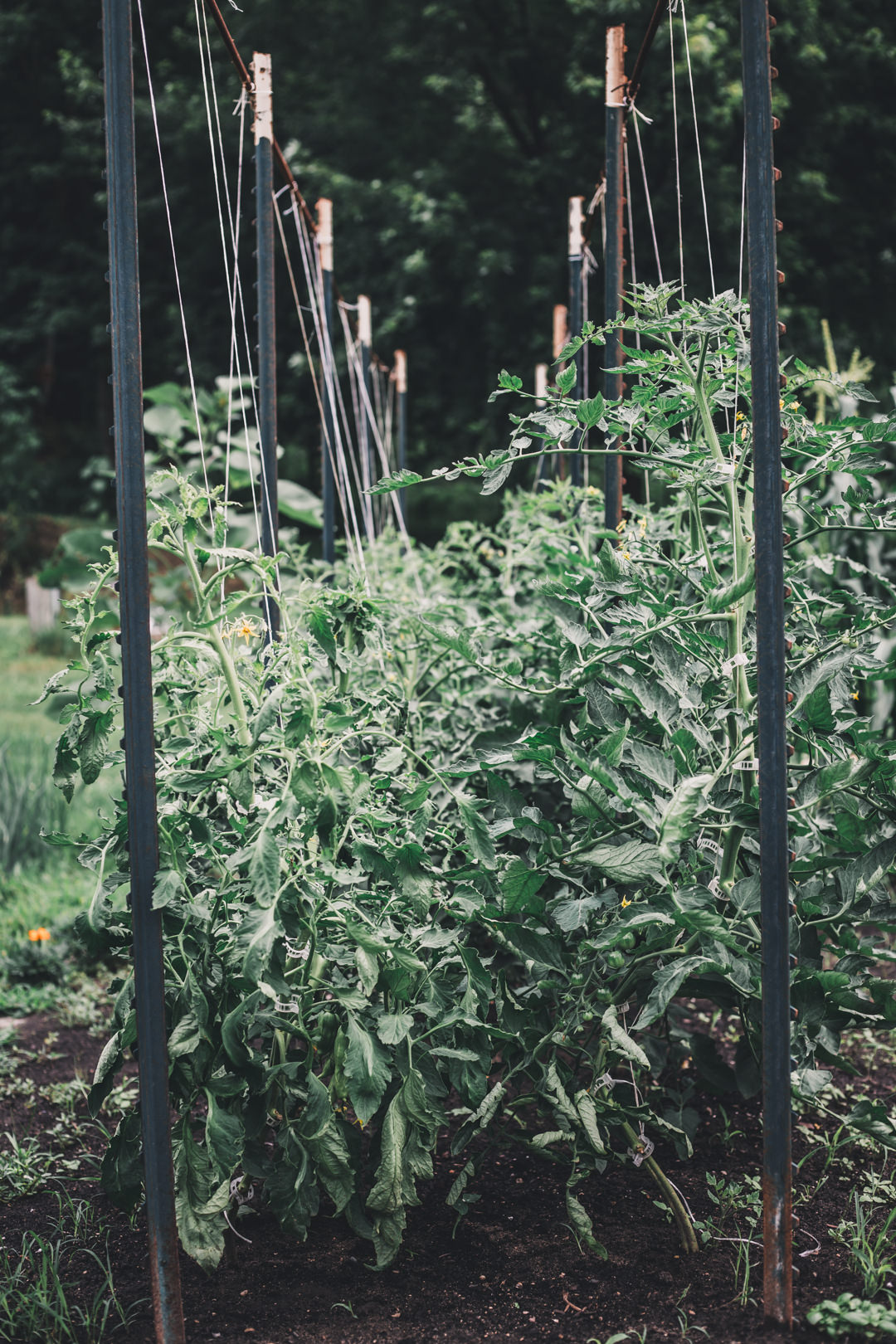
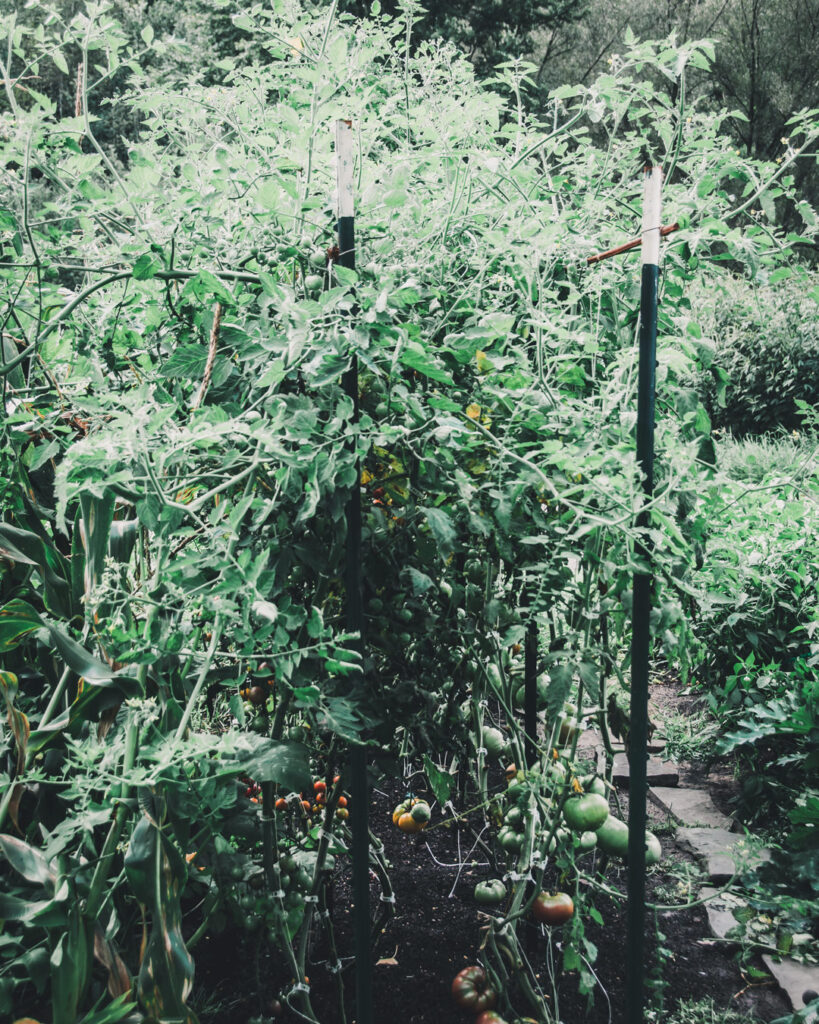

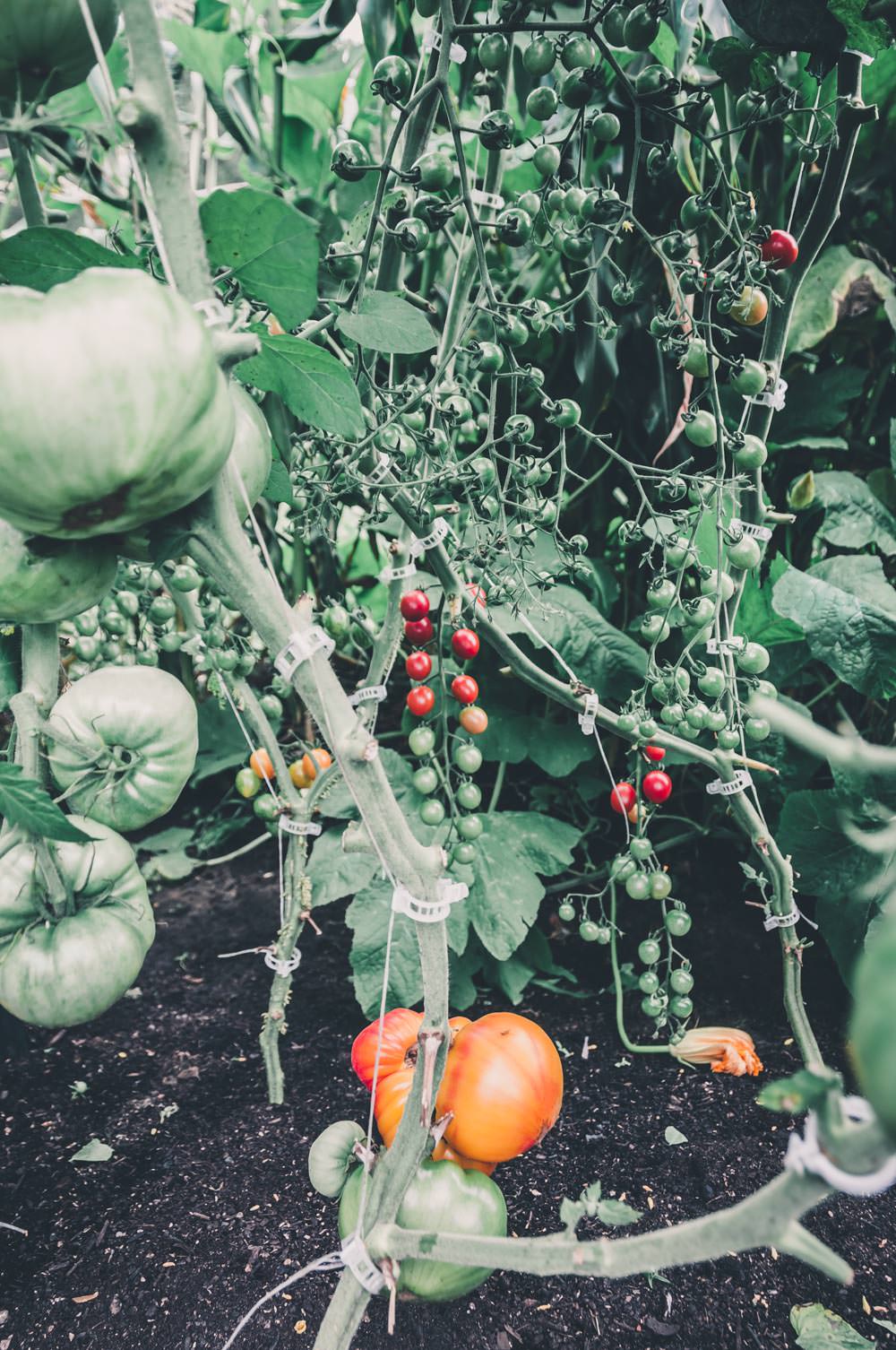
Pruning: N&B
Writing about this would just overcomplicate pruning. It’s really quite simple and Johnny’s has a perfect video here.
Pruning: BTS
I prune to two leaders, just as Johnny’s demonstrates in the above video. That said, I also remove all lower leaves up to the current fruiting cluster (this increases air flow and reduces risk for disease; the plant also has enough leaves on top to take in energy).
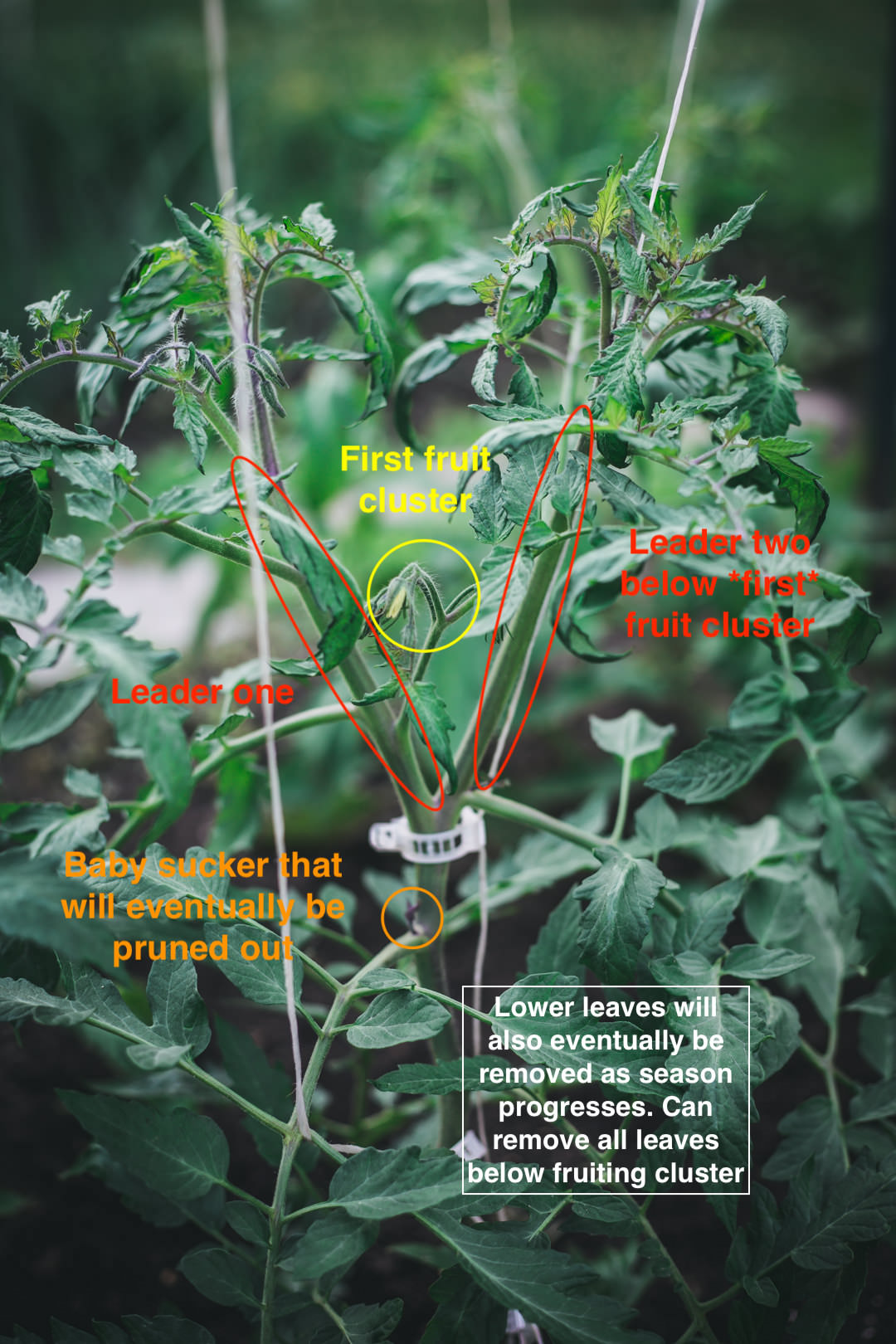
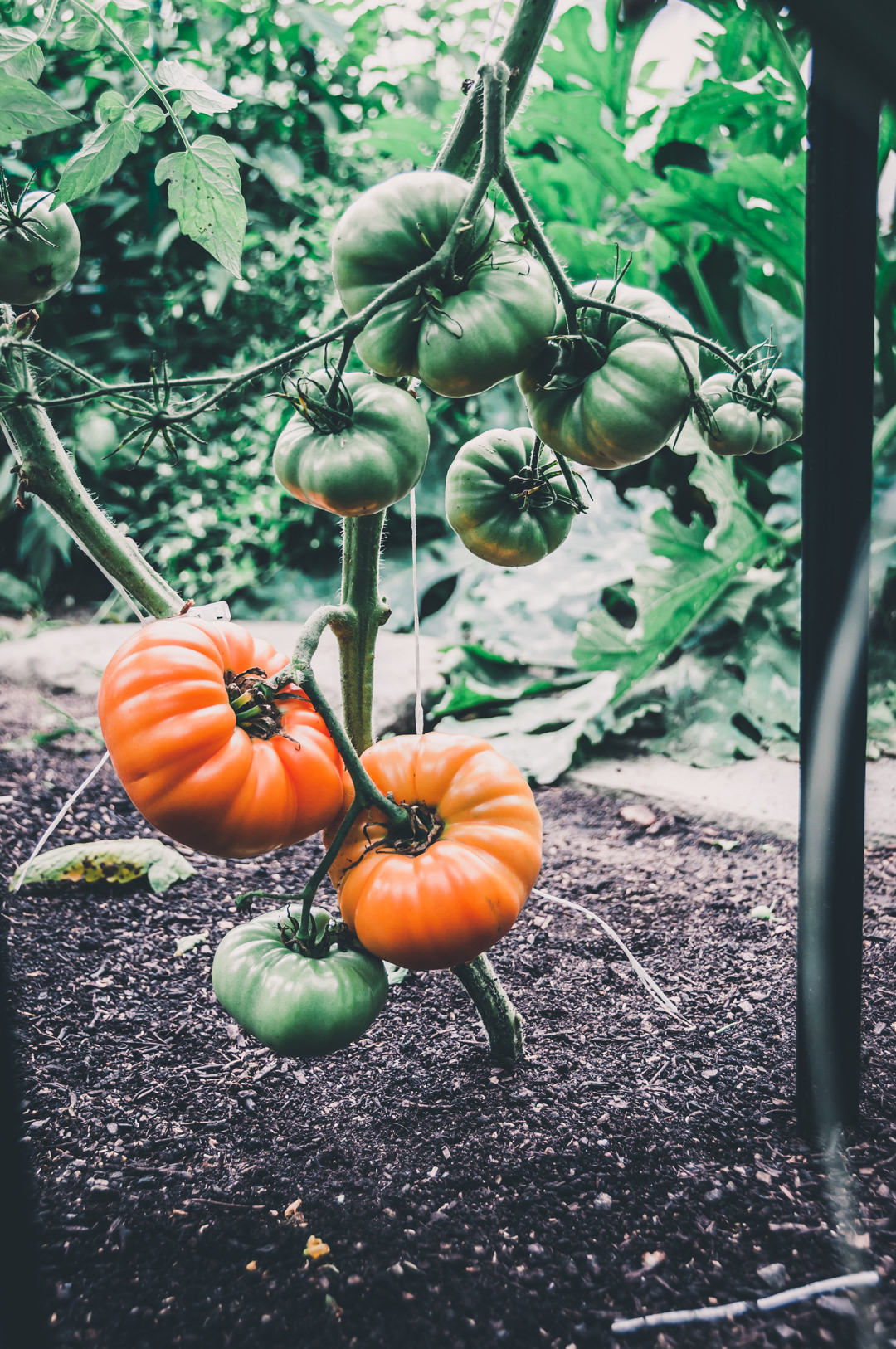
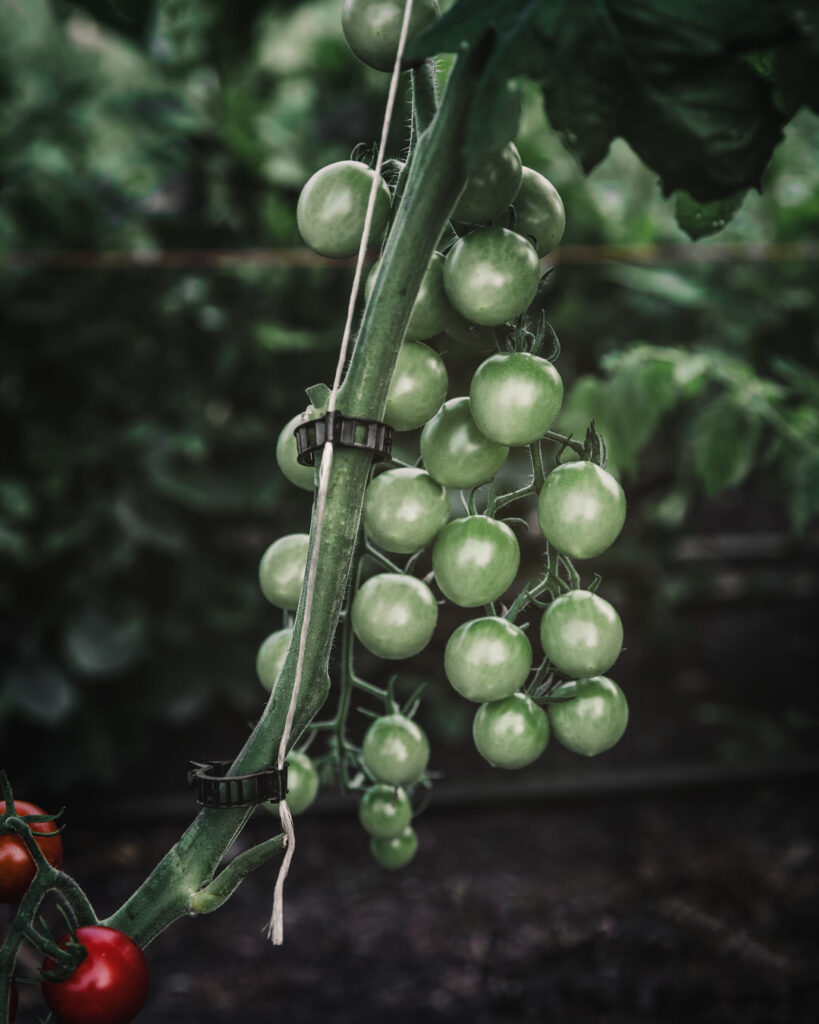
Successions: N&B
While Coleman only mentions one succession, Fortier notes two successions: one transplant in April (started in mid-February) and on in mid-May (presumably started in March).
Successions: BTS
Now that we have the high tunnel, I would love to get an earlier crop in there prior to planting the kitchen garden (which goes in after last frost). However, the flowers take precedence, so I’m normally planting them well past our last frost in both locations. Someday . . . .
Nutrition: N&B
All sources recommend fertilizing based on a soil test. Johnny’s notes that it’s important to accurately fertilize since excess nitrogen causes rampant growth, rot, and delayed ripening. They suggest watering seedlings with a high-phosphate fertilizer solution at planting to help boost early yields.
Coleman plants into beds heavily amended with compost and adds a top-dressing of another inch of compost every six weeks. Fortier fertilizes each month with a mixture of vermicompost, poultry manure, and potassium sulfate.
Nutrition: BTS
I am sure that dialing in your fertilization game per crop is ideal, but we do not do that. We fertilize our fields organically and holistically based on soil tests, while also regularly adding compost. I have an eBook that outlines exactly how we do this. I’ve made that available for you here. The only thing I may do differently with tomatoes is that if I’ve had blossom end rot in the past (where the blossom end of the fruit breaks down and rots), I’ll add calcium to the planting hole.


Drainage & Irrigation: N&B
Most sources recommend drip irrigation. Overhead can be used, but it does increase the chances of disease. Water tomatoes judiciously, especially when it comes to heirloom tomatoes (because their skin is thin). Being careful not to overwater can help to reduce the number of splits (and also increase vine retention). Also, when tomatoes receive more water than needed, the excess is directed into the fruits, which has the effect of diluting flavor. It’s important to water early on when roots are establishing, but only as needed thereafter, which is dependent on the unique soil structure in the grower’s environment (Johnny’s).
Drainage & Irrigation: BTS
At our farm, we have gossil-loamy sand, meaning that our soil is more sand than loam. It actually drains excessively to the point of leaching nutrients. Our biggest difficulty is keep plants irrigated, especially in dry spells. For this reason, we do have drip irrigation installed on all of our beds at the home farm. I don’t worry too much about perfect irrigation for tomatoes, because they are such heavy producers and I’m only using them for special arrangements (the rest, we eat).
Harvest Period: N&B
Coleman notes that the first harvest (from a February 15 sowing) is around June 1 and continues until the middle of November. Fortier notes harvests from mid-June to mid-October.
Harvest Period: BTS
While I’d love to have tomatoes in June, they just are not the focus of our production at this point, so they usually show up in July.
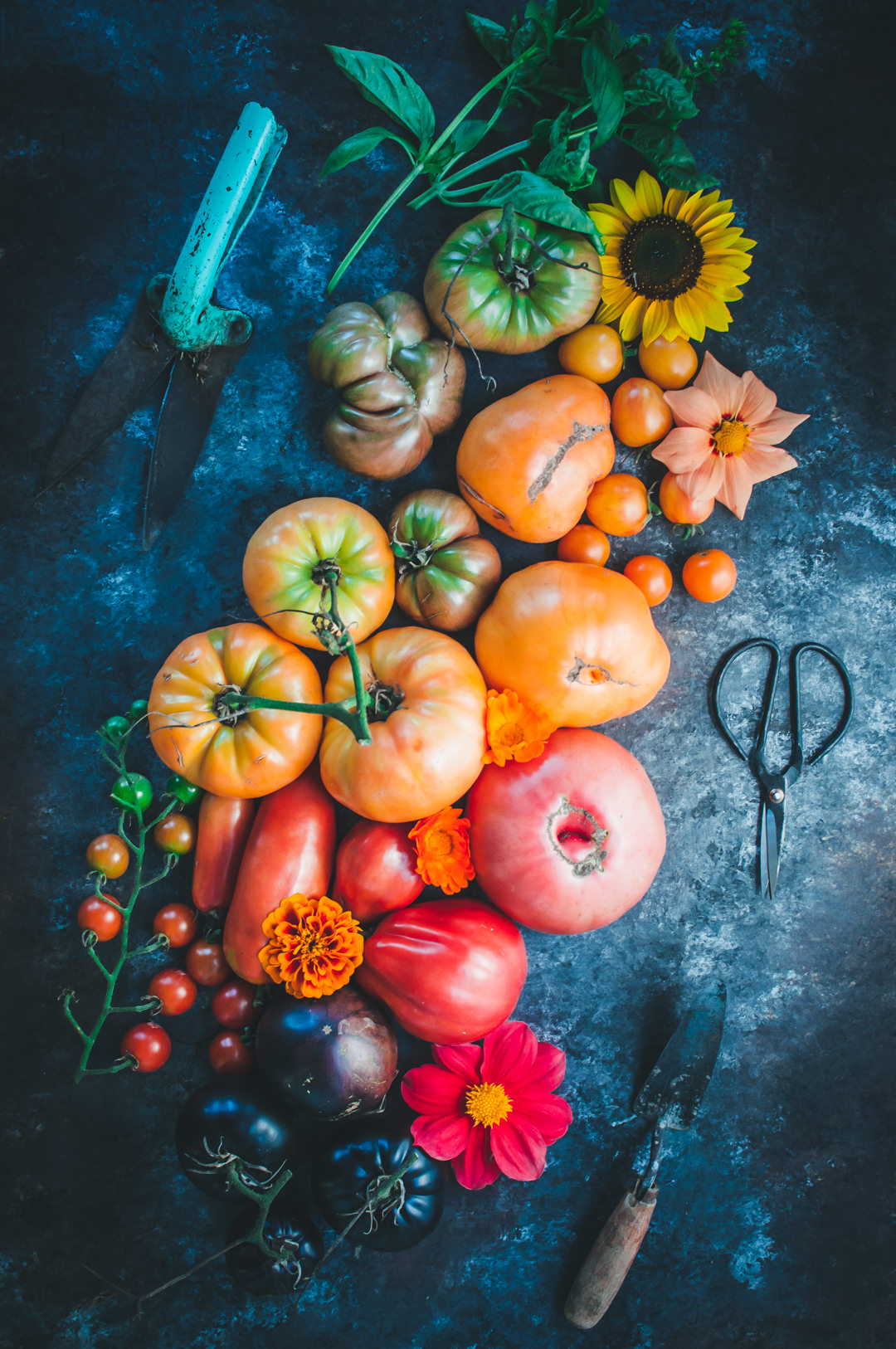
Harvest: N&B
Most sources recommend harvesting once vine ripened and never refrigerating (of course, these are being harvested for consumption, but it’s a point worth noting).
Johnny’s provides the following in-depth instructions:
Fruits ripen gradually from the blossom end to shoulders and from the base of clusters to the tips. Harvest softer fruit unstacked into shallow, padded trays. Use fully ripe fruit only for local retail or home-use. To deliver sound fruit, pick less ripe the further the distance and the longer the time between field and customer. Any fruit breaking color will still ripen post-harvest. Calyx can be removed or kept to prove freshness. Store blemish-free, near-ripe fruit 4–7 days at room temperature in darkness. Store longer with proper variety selection, picking less-ripe, and keeping at cooler temperatures 45–60°F (7–16°C). Colder and picking too green will sacrifice end-quality.
While I wanted to include this storage information, it’s important to note that ripening tomatoes will produce ethylene, which can be damaging to many flowers. For this reason alone, we would not want to store tomatoes with flowers. In general, we’re using tomatoes for special arrangements or events. These are usually tucked in at the very end, and I don’t worry too much about the ripening effect at this point.
Harvest: BTS
Since we’re harvesting to use in arrangements, I prefer to harvest when tomatoes are unripe or partially ripe. The reason for this is that they are much more likely to stay on the vine when they are not ripened. I don’t bother putting them in the refrigerator, I just clip a few vines and put them in the shop (away from flowers) where I’ll be designing later (they do not need a water source).
Pests & Disease: N&B
Tomatoes are relatively easy to grow (they are one of the most-cultivated crops worldwide), but that does not mean they are not without problems. All sources seem to agree that prevention is key when it comes to both pests and diseases.
Coleman relies on crop rotation and proper growing conditions, noting that pest-negative practices are only a short-term solution (and that the long-term solution involves learning how to grow plants correctly). Fortier notes that tomatoes do not suffer terribly from pests. They occasionally get aphids (which they spray with soapy water) and hornworms (which he does not spray because the damage is minor).
When it comes to disease, at the time of writing his book, Fortier notes that they have been growing tomatoes in the same greenhouse (soil/location) for almost a decade without any problems. He credits this to selecting greenhouse tomatoes and grafting tomato plants. Grafting is procedure consisting of cutting two plants with different characteristics (a rootstock that is resistant to disease and a scion which bears the fruit of the desired cultivar) and then splicing them together (more on this below).
If you really want to dive deep on tomato pests and diseases, Johnny’s goes deep into it in this article.
Pests & Disease: BTS
We rarely have any major pest or disease issues with tomatoes. What little we do, I do not treat. I simply remove the plants and practice crop rotation year after year. Grafting tomatoes is a bit of an advanced practice for most growers (unless they are growing for actual production). I have grafted tomatoes and grown them this way (I seriously considered market farming at one point), but I don’t think it’s worth it for our current purposes (we are not selling tomatoes and are not in need of maximum yield). I also like to experiment with a lot of rare, heirloom varieties, and grafting them all would be impractical at this point. If you’re curious about grafting though, it is a totally fun project. As I’m sure you guessed, I followed Johnny’s instructions, which can be found here.
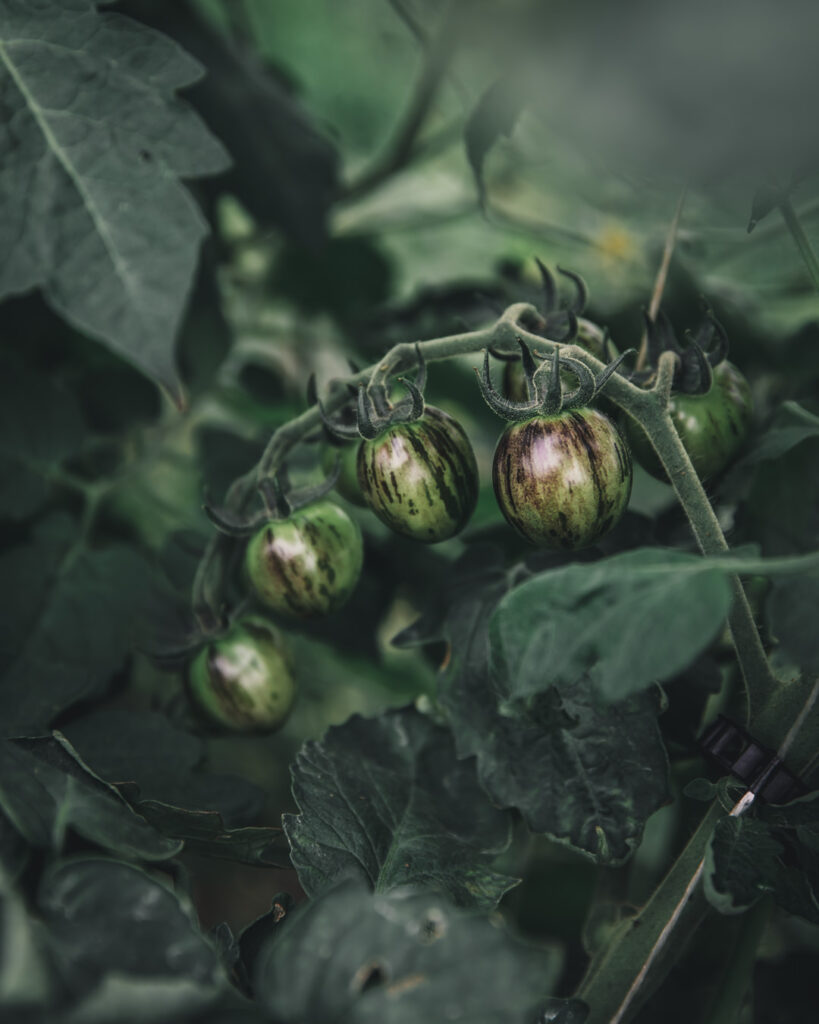

Variety Selection: N&B
Coleman does not mention cherry tomatoes (he only mentions that his favorite indeterminate tomato is Big Beef). Fortier mentions ‘Favorita’ as a favorite cherry tomato. Johnny’s recommends ‘Black Cherry’, ‘White Cherry’, ‘Favorita’, ‘Sun Peach’, ‘Cherry Bomb’, and ‘Sun Gold’.
Variety Selection: BTS
My favorite cherry (or grape) tomatoes for design are Black Strawberry, Blue Cream Berries, Brad’s Atomic Grape, Sunrise Bumblebee, Supersweet 100, Rosella. I’m still trying to see if I can get Blondkopfchen to work because it has these *huge* trusses. Yellow Pear is another good one, but I don’t particularly love the taste so I haven’t grown it for the past few seasons. Napa Chardonnay and Sungold are two of my all-time favorite cherry tomatoes for taste, and they both work great so long as the tomatoes are not overly ripe. Sungold and Supersweet100 clusters can be extremely long sometimes, so it can depend on how big the vase is. I used to grow ‘Matt’s Wild Cherry’ for eating, but eventually cut for other varieties. However, I may bring them back for design because they are super tiny and may work well for smaller design. I get my seeds from Johnny’s, Baker Creek, and Tomatofest.
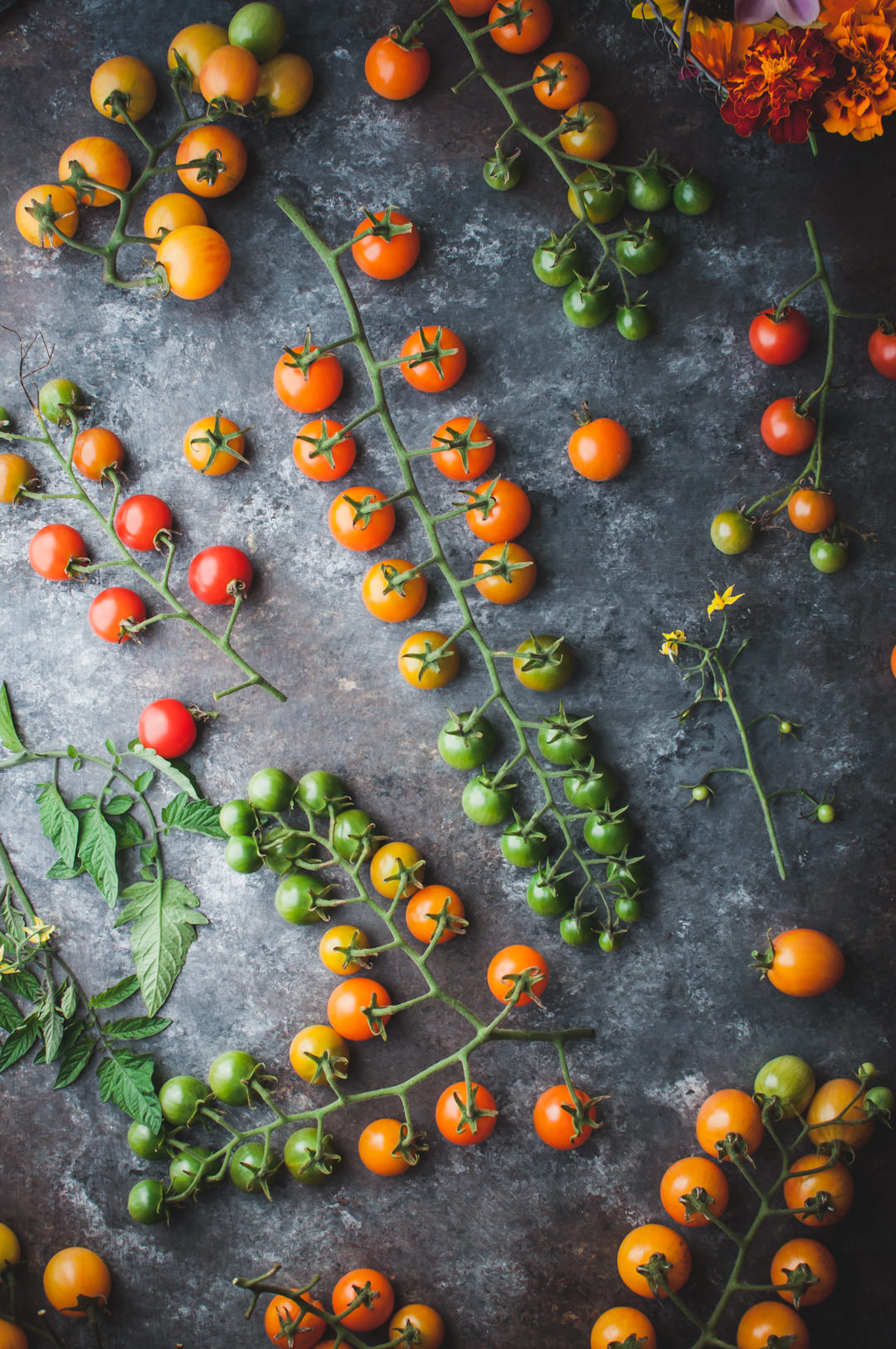
Pricing
At this point, we don’t sell tomatoes individually, so they are part of the overall arrangement cost. For me, I’d grow them either way, so they’re a bonus.
Design
I like to choose tomato colors that compliment the overall arrangement, so you’ll often see that (and why I like to grow different colors). The great thing about cherry tomato vines is that they don’t actually need to be in water. The trick is to get them to hold in the vase. For most of my larger arrangements, I use chicken wire in the base of the vase and clear waterproof tape in the shape of an X at the opening of the vase. Usually, I can easily tuck the vine into the chicken wire to let it hang. If there isn’t enough stem length in the vine, simply cut off the tomatoes at the base.
If the arrangement is not being used right away, I usually keep the tomato vine off and show the client/customer how to attach it (reassuring them that they can also just leave it off the vase and set on the table as next to the arrangement as decor). This not only makes sense for transport, but we’re also reducing the flowers’ exposure to any ethylene produced by the tomatoes.

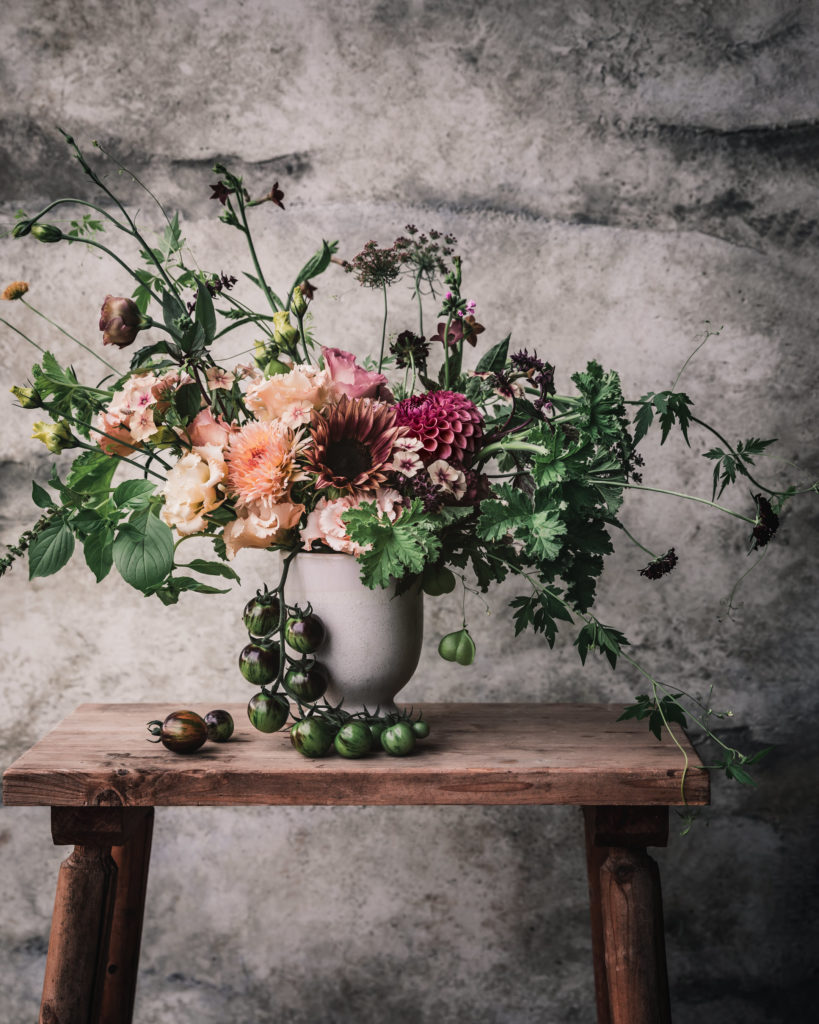




Wrap Up
OK, my friend, that is IT for September’s Plant Profile. What do you think? Was it a fun deviation from the norm? Is there anything that’s unclear or you wish I would have covered? Or is your head spinning? No worries, you will get a copy of this before May goes live, so you can always refer back it. Tip: use the find shortcut (Ctrl+F on a PC or Command+F on a Mac to search for any word or term).
Have any questions or something you want to share with me or others? I know I say this ad nauseam, but I truly believe in the power of the collective and that we all have something unique and powerful to share, so please leave a question or share a comment below. We’re all better for it, and I thank you in advance!
Cheers pal!
comments +